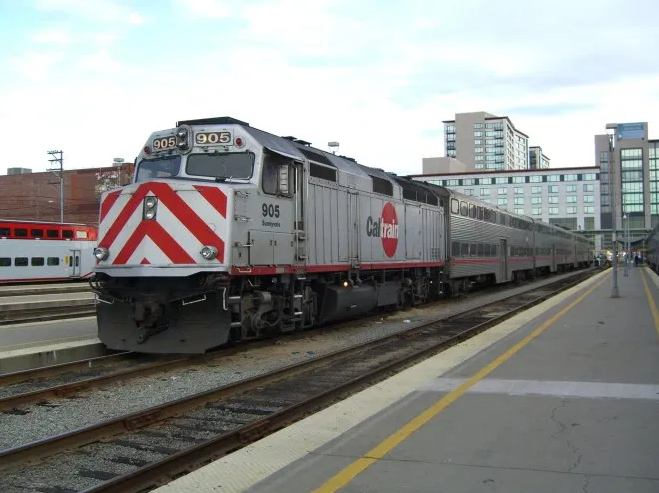American commuter rail systems have long been wedded to the 9-to-5 work schedule, but as the 21st-century economy demands more flexible hours regional rail systems have not kept pace with those changes.
Something has to change as leaders across the country are looking to overhaul one of the most underutilized elements of a region's transit system in order to reverse falling ridership, reduce car dependency, shrink commute times, and curtail traffic congestion. Cities such as Chicago, Boston, Washington D.C. and Philadelphia have suburban rail systems that serve only 2 to 6 percent of commuters — but better and more-frequent service could appeal to car drivers.
Regional rail systems have "underutilized potential," said TransitCenter's Director of Research Steven Higashide.
"What’s really exciting for riders is a vision for all-day frequent service, that is, turning a transit system oriented around 9 to 5 commutes into a service that someone can rely on a much more diverse set of trips," he added.
Transportation officials from Toronto and the Bay Area, who led a discussion about rail service at TransitCenter on Wednesday, are already taking steps to modernize their rail systems and coax commuters out of their cars.
Suburban rail serves up to 25% of all commuters in NY suburbs and 4-5% in Chicago, Boston, Philly.
— Bruce Schaller (@Bruce_Schaller) September 25, 2019
Be interested to hear goals for Caltrains and Toronto commuter rail systems.
(Also interesting that DC Metro and BART suburban shares are close to NYC suburbs) @TransitCenter https://t.co/krPw27Dr4V pic.twitter.com/zQd3oRu9qE
Toronto has been expanding its transit service by increasing the number of rail trips by 50 percent and boosting bus trips by 20 percent from 2015 to 2020. Officials have also sought to keep stations and train cars clean and encouraged employees to assist with customer inquiries on concourses.
Improving the frequency of trips in addition to revamping customer care has made Toronto's Metrolinx rail system one of the most loved in North America — its Up Express service has customer satisfaction ratings in the 80s, and ridership has risen 4.1 percent over the past year.
"One of the biggest lessons that we’ve demonstrated over the last two years is that you have to have a big focus on quality and customers not just cost and efficiencies," Metrolinx President and CEO Phil Verster told Streetsblog. "We’ve started to deploy people out on the concourse answering questions with a friendly face and a friendly answer. It makes a huge difference with people’s journeys."
The Bay Area is on the verge of doing just that. Northern California transportation officials are currently electrifying Caltrain, which could increase the frequency of trains to four times an hour and provide a loop of fast transit connecting San Francisco and Oakland's BART service to San Jose on both sides of the bay.
The $2.26 billion in upgrades, which could be completed by April 2022, can't come quickly enough with 1.2 million more people estimated to live along the route by 2040.
"There’s pent-up demand, all day long all week long for much more frequent service," Friends of Caltrain Executive Director Adina Levin told Streetsblog. "Having trains every 15 minutes as opposed to more regular service can enable better connections with feeder buses and other regional services."
Transit officials still have to improve connectivity between transit services in both San Francisco and San Jose. San Francisco's Salesforce Transit Center is equipped for electric Caltrains but it will cost $6 billion to build a tunnel connecting the transit center with the Caltrain station at Fourth and King streets as well as an underground pedestrian walkway that leads to BART and Muni lines. Another extension connecting BART trains with downtown San Jose could cost $4.7 billion.
Both projects could conceivably take a decade to finish, but advocates say they're on the right track by allowing more frequent service throughout the day.
"Caltrain isn't a commuter rail anymore because the Bay Area is a polycentric region," Levin said. "Instead of a unidirectional commute into a center you have a bidirectional commute pattern, with people coming from different places and going to different destinations."
Some regions are already moving in that direction with piecemeal rail projects. Massachusetts transit advocates want the state's transit authority to institute electrified regional rail along the Worcester-Framingham line while the Mass Pike undergoes a reconstruction. In June, Los Angeles's Metro Board approved the LinkUS Union Station project which would reduce delays and idling at Union Station, allow a one-seat ride between San Diego and San Luis Obispo, and accommodate high-speed rail. And Cook County Board President Toni Preckwinkle is wants to reduce fares and increase service on the Metra Electric and Rock Island train lines in Chicago's South Side and south suburbs, but Chicago Mayor Lori Lightfoot, who worries fewer people would ride local subways as a result, opposes it.
Transit experts hope that city leaders realize that integrating regional rail with local transit systems can be less daunting than it seems.
"In many regions there’s a lot that could be done in terms of improved operations, frequent service, and affordable fares, that don’ts require enormous infrastructure investment," Higashide said. "They just have to run transit system in a different way."






